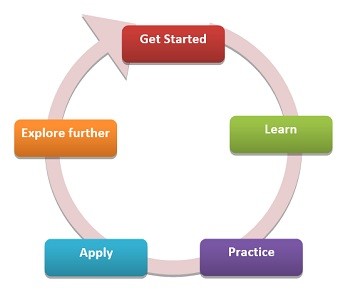Introduction | Get Started | Learn | Practice | Apply | Explore Further | Checkpoint
This Timeline module consists of five steps. Click on Get Started to learn more about this module.
You can navigate through the sections and topics under each step by clicking on the boxes below. To review a section again, simply click on one of the boxes. You can come back to any section at anytime!

- Challenges with timelines
- Why are timelines important?
- What factors need to be considered when managing timelines?
100% rule
The 100% rule is an important design principle for work breakdown structures. It has been defined as follows:
The 100% rule states that the WBS includes 100% of the work defined by the project scope; it captures all deliverables – internal, external, interim – in terms of the work to be completed, including project management. The 100% rule is perhaps the most important principle guiding the development, decomposition and evaluation of the WBS. The rule applies at all levels within the hierarchy. The sum of the work at the “child” level must equal 100% of the work represented by the “parent”. The WBS should not include any work that falls outside the actual scope of the project; that is to say, it cannot include more than 100% of the work. It is important to remember that the 100% rule also applies to the activity level within the project. The work represented by the activities in each work package must add up to 100% of the work necessary to complete the work package.
TIP: The work represented by the activities in each work package must add up to 100% of the work necessary to complete the work package.
Mutually exclusive elements
In addition to the 100% rule, it is important that there is no overlap in scope definition between different elements of a work breakdown structure. The different elements need to remain mutually exclusive. With overlap, ambiguity could result in duplicated work or miscommunication around responsibility or authority. Such overlap can also be problematic in project cost accounting. If the WBS element names are ambiguous, creating a WBS dictionary for the project can help clarify the distinctions between WBS elements. (A WBS Dictionary describes each component of the WBS with information about milestones, deliverables, activities, scope, and sometimes dates, resources, costs, quality.)
Plan outcomes, not actions.
If the WBS designer attempts to capture specific action-oriented details in the WBS, they will likely include either too many actions or too few actions. If too many actions are included they will exceed 100% of the parent’s scope. If too few are included they will fall short of 100% of the parent’s scope. The best way to adhere to the 100% rule is therefore to define WBS elements in terms of outcomes or results, rather than actions. This also prevents the WBS from being overly prescriptive of methodology, allowing project participants to exercise greater ingenuity and creative thinking.
For new product development projects, a project breakdown structure is an excellent technique to ensure an outcome-oriented WBS. When a project provides professional services, all planned deliverables are captured to create a deliverable-oriented WBS. Work breakdown structures that subdivide work by project phases (e.g. preliminary design phase, critical design phase) must ensure that phases are clearly separated by a deliverable that is also used in defining entry and exit criteria (e.g. an approved preliminary or critical design review).
Level of detail
It takes experience to decide when to stop dividing work into smaller elements in the WBS process. Keep in mind that there are several heuristics – or “rules of thumb” – used when determining the appropriate duration of an activity or group of activities necessary to produce a specific deliverable defined by the WBS.
The first is the “80 hour rule”. The “80 hour rule” means that no single activity or group of activities -at the lowest level of detail of the WBS (to produce a single deliverable) – should be more than 80 hours of effort.
The second rule of thumb is that, at the lowest level of detail, no activity or group of activities should be longer than a single reporting period. So if the project team is reporting progress monthly, then no single activity or series of activities should be longer than one month long.
The last heuristic is the “if it makes sense” rule. Applying this rule, one can apply “common sense” when creating the duration of a single activity or group of activities necessary to produce a deliverable defined by the WBS.
A work package at the activity level is a task that:
- can be confidently and realistically estimated;
- makes no sense to break down any further;
- can be completed in accordance with one of the rules defined above;
- produces a measurable deliverable; and
- forms a unique package of work.